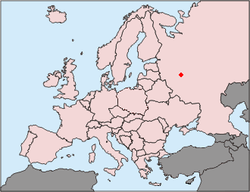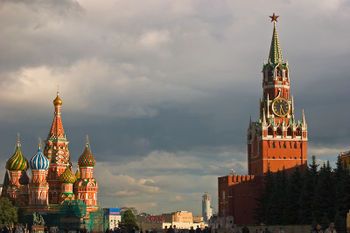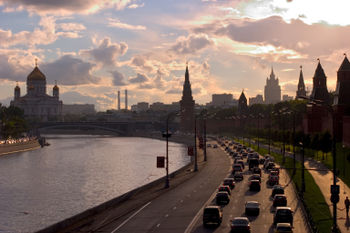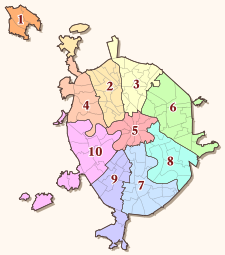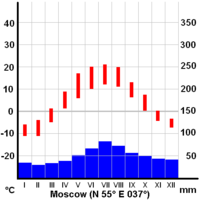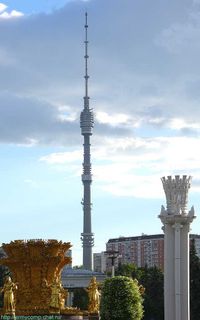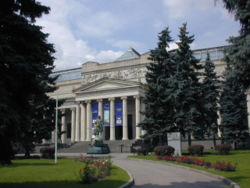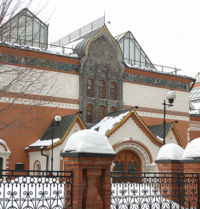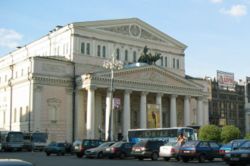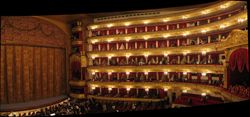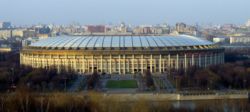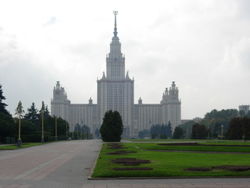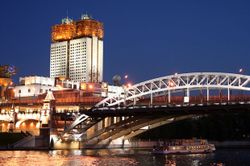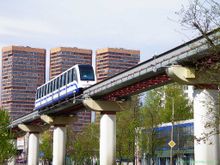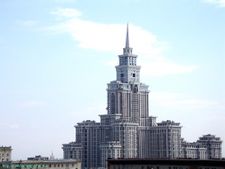Moscow
2007 Schools Wikipedia Selection. Related subjects: Geography of Great Britain
|
|||||
| Location | |||||
|---|---|---|---|---|---|
| Position of Moscow in Europe | |||||
| Government | |||||
| Country District Subdivision |
Russia Central Federal District Federal City |
||||
| Mayor | Yuriy Luzhkov | ||||
| Geographical characteristics | |||||
| Area - City |
1,081 km² |
||||
| Population - City (2005) - Density |
10,415,400 8537.2/ km² |
||||
| Coordinates | |||||
| Elevation | <130 - 253 m | ||||
| Time zone - Summer ( DST) |
MSK ( UTC+3) MSD ( UTC+4) |
||||
| Other Information | |||||
| Postal Code | 101xxx-129xxx | ||||
| Dialing Code | +7 495; +7 499 | ||||
| License plate | 77, 99, 97, 177 | ||||
| Website: www.mos.ru | |||||
Moscow (Russian: Москва́, Moskva, IPA: [mʌsk'va] ) is the capital of Russia and the country's principal political, economic, financial, educational, and transportation centre, located on the Moskva River in the Central Federal District, located in the European part of Russia. The city's population of 10.4 million permanent inhabitants within the city boundaries constitutes about 7% of the total Russian population. Likewise, it is the most populous city in Europe. Historically, its position was central in the Russian homeland. It was the capital of the former Soviet Union and Muscovite Russia, the pre-Imperial Russian state. It is the site of the famous Kremlin, which now serves as the ceremonial residence of the President.
Moscow's architecture and performing arts culture are world-renowned. Moscow is also well known as the site of Saint Basil's Cathedral, with its elegant onion domes, as well as the Cathedral of Christ the Savior. The Patriarch of Moscow, whose residence is the Danilov Monastery, serves as the head of the Russian Orthodox Church. Moscow also remains a major economic centre and is home to a large number of billionaires; it is perennially considered one of the most expensive cities for expatriate employees in the world. It is home to many scientific and educational institutions, as well as numerous sport facilities. It possesses a complex transport system that includes the world's busiest metro system, which is famous for its architecture. Moscow also became the host of the 1980 Summer Olympics.
History
The first reference to Moscow dates from 1147 when Yuri Dolgoruki called upon the prince of the Novgorod Republic to "come to me, brother, to Moscow." Nine years later, in 1156, Prince Yuriy Dolgorukiy of Kiev ordered the construction of a wooden wall, which had to be rebuilt multiple times, to surround the emerging Moscow. After the sacking of 1237-1238, when the Mongol- Tatars burned the city to the ground and killed its inhabitants, Moscow recovered and became the capital of an independent principality in 1327. Its favorable position on the headwaters of the Volga river contributed to steady expansion. Moscow developed into a stable and prosperous principality for many years and attracted a large number of refugees from across Russia.
Under Ivan I the city replaced Tver as capital of Vladimir-Suzdal and became the sole collector of taxes for the Mongol- Tatar rulers. By paying high tribute, Ivan won an important concession from the Khan. Unlike other principalities, Moscow was not divided among his sons but was passed intact to his eldest. In 1380, prince Dmitry Donskoy of Moscow led a united Russian army to an important victory over the Tatars in the Battle of Kulikovo. After that, Moscow took the leading role in liberating Russia from Tatar domination. In 1480, Ivan III had finally broken the Russians free from Tatar control, allowing Moscow to become the centre of power in Russia. The Russian capital, which had wandered from Kiev to Vladimir, came to rest in this city by the end of his reign, and Moscow became the capital of an empire that would eventually encompass all of present-day Russia and parts of other lands.
The 17th century was rich in popular risings, such as the liberation of Moscow from the Polish-Lithuanian invaders (1612), the Salt Riot (1648), the Copper Riot (1662), and the Moscow Uprising of 1682. The city ceased to be Russia's capital in 1712, after the founding of St. Petersburg by Peter the Great on the Baltic coast in 1703. When Napoleon invaded in 1812, the Muscovites burned the city and evacuated, as Napoleon's forces were approaching on September 14. Napoleon's army, plagued by hunger, cold, and poor supply lines, was forced to retreat. In January 1905, the institution of the City Governor, or Mayor, was officially introduced in Moscow, and Alexander Adrianov became Moscow's first official mayor. Following the success of the Russian Revolution of 1917, on March 12, 1918, Moscow became the capital of the Russian Soviet Federative Socialist Republic and the Soviet Union less than five years later.
During the Great Patriotic War, the Soviet State Committee of Defence and the General Staff of the Red Army was located in Moscow. In 1941, sixteen divisions of the national volunteers (more than 160,000 people), twenty-five battalions (18,500 people) and four engineering regiments were formed among the Muscovites. In November 1941, German Army Group Centre was stopped at the outskirts of the city and then driven off in the course of the Battle of Moscow. Many factories were evacuated, together with much of the government, and from October 20 the city was declared to be under siege. Its remaining inhabitants built and manned antitank defenses, while the city was bombarded from the air. It is of some note that Stalin refused to leave the city, meaning the general staff and the council of people's commissars remained in the city as well. Despite the siege and the bombings, the construction of Moscow's metro system, which began in the early 1930s, continued through the war and by the end of the war several new metro lines were opened. On May 1, 1944 a medal For the defence of Moscow and in 1947 another medal In memory of the 800th anniversary of Moscow were instituted. On May 8, 1965 in commemoration of the 20th anniversary of the victory in World War II, Moscow was one of twelve Soviet cities awarded the title of the Hero City. In 1980, it hosted the Summer Olympic Games.
In 1991 Moscow was the scene of a coup attempt by the government members opposed to the reforms of Mikhail Gorbachev. When the USSR was dissolved in the same year, Moscow continued to be the capital of Russia. Since then, the emergence of a market economy in Moscow has produced an explosion of Western-style retailing, services, architecture, and lifestyles.
Government
Moscow is the seat of power for the Russian Federation. At the centre of the city, in the Central Administrative Okrug, is the Moscow Kremlin, which houses the home of the President of Russia as well as many of the facilities for the national government. This includes numerous military headquarters and the headquarters of the Moscow Military District. Moscow, like with any national capital, is also the host of all the foreign embassies and diplomats representing a multitude of nations in Russia. On a slightly smaller scale, Moscow is located within the Central Federal District, one of the seven federal districts of Russia. As result, it falls under the administration of a representative appointed by the President of Russia to head the district. Moscow is also designated as one of only two federal cities - Saint Petersburg being the other - within Russia. Since all Russian subjects - republics, provinces, cities, and territories - have two representatives within the Federation Council of Russia, the over 10 million Muscovites are represented by just two people - 1.1% of the Council - despite the fact that they account for 7.3% of the total population of Russia. Lastly, Moscow is located within the central economic region, one of twelve regions within Russia with similar economic goals.
The entire city of Moscow is headed by one mayor (currently Yuriy Luzhkov). It is divided into 10 administrative ( okrugs) and 123 municipal districts. Administrative districts: Zelenogradskiy Administrative Okrug (City of Zelenograd in the federal classification), Northern Administrative Okrug, North-Eastern Administrative Okrug, North-Western Administrative Okrug, Central Administrative Okrug, Eastern Administrative Okrug, Southern Administrative Okrug, South-Eastern Administrative Okrug, South-Western Administrative Okrug, and Western Administrative Okrug. Nine of the ten administrative districts, except of Zelenogradskiy, are located within City of Moscow main boundaries.
Each administrative district consists of several municipal districts ( raions). Each municipal and administrative district has its own coat of arms, flag, and elected head official. Additionally, most raions have their own cable television, computer network, and official newspaper. Along with municipal districts are Territorial Unities with Special Status or territories. These usually include areas with small or no permanent populations, such as the case with the All-Russia Exhibition Centre, the Botanical Garden, large parks, and industrial zones. In recent years, some territories have been merged with different raions. There are no ethnic-specific raions in Moscow in the manner Chinatowns exist in some North American and East Asian cities. And although raions are not designated by income, as with most cities, those areas that are closer to the city centre, metro stations or green zones are considered more prestigious.
In addition to being the capital of Russia, Moscow is the capital of the Moscow Oblast. Since Moscow is a Federal City, it is not actually within the oblast. (See List of capitals outside of the territories they serve.)
Climate
Moscow is exposed to cold winters, warm and mild summers, and very brief spring and autumn seasons. Typical high temperatures in the warm months of July and August are around 23 °C (68 °F); in the winter, temperatures normally drop to approximately -12 °C (10 °F). Monthly rainfall totals vary minimally throughout the year, although the precipitation levels tend to be higher during the summer than during the winter. Due to the significant variation in temperature between the winter and summer months as well as the limited fluctuation in precipitation levels during the summer, Moscow is considered to be within a continental climate zone.
City layout
Moscow is situated on the banks of the Moskva River, which flows for just over five hundred kilometers through western Russia, in the centre of the East-European plain.
Moscow's road system is centered roughly around the heart of the city, the Moscow Kremlin. From there, the roads in general radiate out to intersect with a sequence of circular roads or "rings" focused at the Kremlin.
The first and innermost major ring, Bulvarnoye Koltso ( Boulevard Ring), was built at the former location of the sixteenth century city wall around what used to be called Bely Gorod (White Town). The Bulvarnoye Koltso is technically not a ring; it does not form a complete circle, but instead a horseshoe-like arc that goes from the Cathedral of Christ the Saviour to the Yauza River. In addition, the Boulevard Ring changes street names numerous times throughout its journey across the city.
The second primary ring, located outside the Boulevard Ring, is the Sadovoye Koltso ( Garden Ring). Like the Boulevard Ring, the Garden Ring follows the path of a sixteenth century wall that used to encompass part of the city. The third ring, the Third Transport Ring, was completed in 2003 as a high-speed freeway. The Fourth Transport Ring, another freeway, is currently under construction to further reduce traffic congestion. The outermost ring within Moscow is the Moscow Automobile Ring Road (often called the MKAD from the Russian Московская Кольцевая Автомобильная Дорога), which forms the approximate boundary of the city.
Outside the city, some of the roads encompassing the city continue to follow this circular pattern seen inside city limits.
Architecture
For a long time the view of the city was dominated by numerous orthodox churches. The look of the city changed drastically during Soviet times, mostly due to Joseph Stalin, who oversaw a large-scale effort to modernize the city. He introduced broad avenues and roadways, some of them over ten lanes wide, but he also destroyed a great number of historically significant architectural works. The Sukharev Tower, as well as numerous mansions and stores lining the major streets, and various works of religious architecture, such as the Kazan Cathedral and the Cathedral of Christ the Saviour, were all destroyed during Stalin's rule. During the 1990s, however, both the latter were rebuilt.
Architect Vladimir Shukhov was responsible for building several of Moscow's landmarks during early Soviet Russia. The Shukhov Tower, just one of many hyperboloid towers designed by Shukhov, was built between 1919 and 1922 as a transmission tower for a Russian broadcasting company. Shukhov also left a lasting legacy to the Constructivist architecture of early Soviet Russia. He designed spacious elongated shop galleries, most notably the Upper Trade Rows (GUM) on Red Square, bridged with innovative metal-and-glass vaults.
Stalin, however, is also credited with building the The Seven Sisters, comprising seven, cathedral-like structures. A defining feature of Moscow's skyline, their imposing form was allegedly inspired by the Municipal Building in New York, and their style - with intricate exteriors and a large central spire - has been described as Stalinist gothic architecture. All seven towers can be seen from most elevations in the city; they are among the tallest constructions in central Moscow apart from the Ostankino Tower which, when it was completed in 1967, was the tallest free-standing land structure in the world and today remains the world's second-tallest. The Soviet policy of providing mandatory housing for every citizen or their family, and the rapid growth of the Muscovite population in Soviet times, also led to the construction of large, monotonous housing blocks, which can often be differentiated by age, sturdiness of construction, or 'style' according to the neighbourhood and the materials used. Most of these date from the post-Stalin era and the styles are often named after the leader then in power - Brezhnev, Khrushchev, etc - and they are usually ill-maintained. The Stalinist-era constructions, usually in the central city, are massive and usually ornamented with Socialist realism motifs that imitate classical themes. However, small churches - almost always Eastern Orthodox - that hint on the city's past still dot various parts of the city. The Old Arbat, a popular tourist street that was once the heart of a bohemian area, preserves most of its buildings from prior to the twentieth century. Many buildings found off the main streets of the inner city (behind the Stalinist façades of Tverskaya Street, for example) are also examples of the bourgeois decadence in Tsarist times. Ostankino, Kuskovo, Uzkoye and other large estates just outside Moscow originally belong to nobles from the Tsarist era, and some convents and monasteries, both inside and outside the city, are open to Muscovites and tourists.
Attempts are being made to restore many of the city's best-kept examples of pre-Soviet architecture. These revamped structures are easily spotted by their bright new colours and spotless facades. There are a few examples of notable, early Soviet avant-garde work too, such as the house of the architect Konstantin Melnikov in the Arbat area. Later examples of interesting Soviet architecture are usually marked by their impressive size and the semi- Modernist styles employed, such as with the Novy Arbat project, familiarly known as "false teeth of Moscow" and notorious for the wide-scale disruption of a historic area in the Moscow downtown involved in the project.
Like in London, but on a broader scale, plaques on the house exteriors will inform passers-by that a well-known personality once lived there. Frequently the plaques are dedicated to Soviet celebrities not well-known to the outside world. There are also many 'house-museums' of famous Russian writers, composers, and artists in the city.
Views of Moscow
|
Triumphal arch on Kutuzov Avenue, dedicated to victory over Napoleon's army. |
|||
Culture
Museums and galleries
Many of Moscow's museums and galleries have collections that can be compared to those of the best museums of Western Europe and North America. Frequent art exhibitions thrive on both the new and the classic, as they once did in pre- Revolutionary times, and are derived from diverse branches of the arts - painting, photography, and sculpture.
One of the most notable art museums in Moscow is the Tretyakov Gallery, which was founded by Pavel Tretyakov, a wealthy patron of the arts who donated a large private collection to the city. Currently the Tretyakov Gallery is split into two buildings. The Old Tretyakov, the original gallery in the Tretyakovskaya area on the south bank of the Moskva River, houses the works of the classic Russian tradition. The works of famous pre- Revolutionary painters, such as Ilya Repin, as well as the works of early Russian icon painters can be found in the Old Tretyakov Gallery. Visitors can even see rare originals by early-fifteenth century iconographer Andrei Rublev. The New Tretyakov, created in Soviet times, mainly contains the works of Soviet artists, as well as of a few contemporary artists, but there is some overlap with the Old Tretyakov Gallery for early twentieth century art. The new gallery includes a small reconstruction of Vladimir Tatlin's famous Monument to the Third International and a mixture of other avant-garde works by artists like Kazimir Malevich and Wassily Kandinsky. Socialist realism features can also be find within the halls of the New Tretyakov Gallery.
Another art museum in the city of Moscow is the Pushkin Museum of Fine Arts, which was founded by, among others, Marina Tsvetaeva's father. The Pushkin Museum is similar to the British Museum in London in that its halls are a cross-section of world civilizations, with many plaster casts of ancient sculptures. However, it also hosts famous paintings from every major Western era of art; works by Claude Monet, Paul Cézanne, and Pablo Picasso are all sampled there.
The State Historical Museum of Russia (Государственный Исторический музей) is a museum of Russian history wedged between Red Square and Manege Square in Moscow. Its exhibitions range from relics of the prehistoric tribes inhabiting present-day Russia, through priceless artworks acquired by members of the Romanov dynasty. The total number of objects in the museum's collection numbers in the millions. The Polytechnical Museum, founded in 1872 is the largest technical museum in Russia, offering a wide array of historical inventions and technological achievements, including humanoid automata of the 18th century and the first Soviet computers. Its collection contains more than 160,000 items. The Borodino Panorama museum located on Kutuzov Avenue provides an opportunity for visitors to experience being on a battlefield with a 360° diorama. It is a part of the large historical memorial commemorating the victory in the Patriotic War of 1812 over Napoleon's army, that includes also the Triumphal arch erected in 1827.
Theatres and other performing arts
Moscow is also the heart of Russian performing arts, including ballet and film. There are ninety-three theaters, 132 cinemas and twenty-four concert-halls in Moscow.
Among Moscow's many theatres and ballet studios is the Bolshoi Theatre and the Malyi Theatre as well as Vakhtangov Theatre and Moscow Art Theatre. The repertories in a typical Moscow season are exhaustive and modern interpretations of classic works, whether operatic or theatrical, are quite common. State Central Concert Hall Rossia , famous for ballet and estrade performances, is the place of frequent concerts of pop-stars such as Alla Pugacheva and is situated in the soon to be demolished building of Hotel Rossiya, the largest hotel in Europe.
Moscow International Performance Arts Centre, opened in 2003, also known as Moscow International House of Music, is known for its performances in classical music. It also has the largest organ in Russia installed in Svetlanov hall.
There are also two large circuses in Moscow: Moscow State Circus and Moscow Circus on Tsvetnoy Boulevard named after Yuri Nikulin.
Soviet films are integral to film history and the Mosfilm studio was at the heart of many Soviet classic films as it is responsible for both artistic and mainstream productions. . However, despite the continued presence and reputation of internationally-renowned Russian filmmakers, the once prolific native studios are much quieter. Rare and historical films may be seen in Salut cinema where films from the Museum of Cinema collection are shown regularly.
Parks and landmarks
There are 96 parks and 18 gardens in Moscow, including 4 botanical gardens. There are also 450 square kilometres of green zones besides 100 square kilometres of forests . Moscow is a very green city if compared to other cities of comparable size in Western Europe and America. There are average 27 square meters of parks per person in Moscow compared with 6 for Paris, 7.5 in London and 8.6 in New York.
The Central Park of Culture and Rest named after Maxim Gorky founded in 1928. The main part with area of 689,000 square metres along the Moskva river contains estrades, children attractions, including the Observation Wheel water ponds with boats and water bicycles, dancings, tennis courts and other sport facilities. It borders the Neskuchniy Garden with area of 408,000 square metres — the oldest park in Moscow, and a former Emperor's residence, created as a result of intergration of three estates of XVIII century, which contains also the Green Theatre, one of the largest open aphiteaters in Europe, able to contain up to 15 thousand people .
Izmaylovsky Park created in 1931 is one of the largest parks in the world. Its area of 15.34 km² is 6 times greater than that of Central Park in New York.
Sokolniki park, which got its name for famous falcon huntings occurred here in the past, is one of the oldest in Moscow and with area of 6 square kilometres four times greather than London's Hyde Park. From a central circle with a large fountain radiate birch, maple and elm alleys. Farther, after the Deer ponds, there is a labirint, composed of green paths.
Losiny Ostrov National Park (literally - "Elk Island"), bordering the Sokolniki park, with total area of more than 116 km² is the first national park of Russia, located in Moscow and Moscow Oblast. It is presumed to be the largest forest in a city of comparable size. It is also known as the "city taiga", where living elks can be met.
Tsytsin Main Moscow Botanical Garden of Academy of Sciences, founded in 1945 is the largest in Europe . It covers territory of 3.61 km² bordering the All-Russian Exhibition Centre and contains a live exhibition of more than 20 thousand of different species of plants from different parts of the world as well as scientific research laboratory. It also contains a rosarium with 20 thousand rose bushes, dendrarium and an oak forest with average age of trees exceeding 100 years as well as a greenhouse on more than 5000 square meters.
Lilac park founded in 1958 is known for its permanent sculpture exposition and a large rosarium.
Moscow has always been a popular destination for tourists. Some of the better known attractions include the city's UNESCO World Heritage Site, Moscow Kremlin and Red Square, which was built between the 14th and 17th centuries. Kolomenskoye is another popular attraction with its UNESCO World Heritage Site, the Church of the Ascension, which dates from 1532.
Other popular attractions include the Moscow Zoo, home to nearly a thousands species and more than 6,500 specimens. Each year, the zoo attracts more than 1.2 million adult visitors. The long days will also afford one more time to cover the immense wealth of historical, cultural or simply popular sites in Moscow.
Moscow tourist attractions
Bolshoi Theatre | Kolomenskoye | Kremlin | Poklonnaya Hill | Kuskovo | Manege | Europe's tallest tower | Shukhov Tower | Stalinist skyscrapers | Ostankino Palace | Pushkin Museum of Fine Arts | Red Square with Lenin's mausoleum, Monument to Minin and Pozharsky, and Lobnoye Mesto | Saint Basil's Cathedral | Novodevichy Convent | Donskoy Monastery | Komsomolskaya Square | Simonov Monastery | Red Gate | Bolshoi Kamennyi Bridge | Cathedral of Christ the Saviour | State Tretyakov Gallery | All-Russian Exhibition Centre | Alexander Garden | Moscow Zoo | Patriarch's Ponds | Moscow State University | Krutitsy | Elokhovo Cathedral | Nativity Church in Putinki | Menshikov Tower | Iberian Gate and Chapel | Kazan Cathedral | Church of the Intercession at Fili | Gostiny Dvor | Tretyakov Drive | GUM | State Historical Museum | Moscow City Hall | White House, Moscow | All-Russia Exhibition Centre and Monument to the Conquerors of Space| Melnikov Mansion | Old Arbat | Moscow Metro | Moscow-City | Uzkoye
Sports
Moscow is home to more Olympic champions than any other city in the world. It was the host city of the 1980 Summer Olympics, although the yachting events were held at Tallinn, in present-day Estonia. Large athletic facilities and the main international airport, Sheremetyevo Terminal 2, were built in preparation for the 1980 Summer Olympics. Moscow had also made a bid for the 2012 Summer Olympics. However, when final voting commenced on July 6, 2005, Moscow was the first city to be eliminated from further rounds. The Games were finally awarded to London.
Moscow is home to sixty-three stadiums (besides eight football and eleven light athletics maneges), of which Luzhniki Stadium is the largest and the 4th biggest in Europe. Forty other sport complexes are located within the city, including twenty-four with artificial ice. There are also seven horse racing tracks in Moscow, of which Central Moscow Hippodrome, founded in 1834, is the largest.
Football is probably the most popular spectator sport among the young, followed by ice hockey. Clubs such as Dynamo, CSKA, Lokomotiv, Spartak and Zenit Saint Petersburg are prominent on the European stage.
Because of Moscow's cold locale, winter sports have a large following as well. Many of Moscow's large parks offer marked trails for skiers and frozen ponds and canals for skaters.
Moscow also hosts the annual Kremlin Cup, a popular tennis tournament on both the WTA and ATP tours. In 2006 the event is to be held from the 9th-15th October on both the women and men's tennis tour. It is regarded as a very prestigious tournament and is one of the ten Tier-I events on the womens' tour and a host of Russian players feature every year.
Leisure and entertainment
There is a vibrant night life in Moscow. The major and one of the most popular nightlife areas is around Tverskaya Street. The southern part of Tverskaya Street near the Manege Square and the Red Square area is known as an area with many expensive, luxurious bars and restaurants, and is considered being a playground for New Russians and celebrities. Tverskaya Street is also one of the busiest shopping streets in Moscow. The adjoining Tretyakovsky Proyezd, also south of Tverskaya Street, in Kitai-gorod is one of the most expensive shopping streets in Europe . Many prestigeous night clubs and casinos, such as Metelitsa located along Noviy Arbat street. There also many other different night clubs of various ideology including those for gays, lesbians and bisexuals.
Education
There are 1696 high schools in Moscow, as well as 91 colleges. Besides these, there are 222 institutions offering higher education in Moscow, including 60 state universities and the Lomonosov Moscow State University, which was founded in 1755. The university main building located in Vorobyovy Gory ( Sparrow Hills) is 240-meter-tall and when completed, was the tallest building outside the United States. The university has over 30,000 undergraduate and 7,000 postgraduate students, who have a choice of twenty-nine faculties and 450 departments for study. Additionally, approximately 10,000 high school students take courses at the university, while over two thousand researchers work. The Moscow State University library contains over nine million books, making it one of the largest libraries in all of Russia. Its acclaim throughout the international academic community has meant that over 11,000 international students have graduated from the university, with many coming to Moscow to learn the Russian language.
Bauman Moscow State Technical University, founded in 1830, is located in the centre of Moscow and provides more than 18,000 undergraduate and 1,000 postgraduate students with an education in science and engineering offering a wide range of technical degrees. Since it opened enrollment to students from outside Russia in 1991, Bauman Moscow State Technical University has increased its international enrollment to up to two hundred.
The Moscow Conservatory, founded in 1866 is a prominent music school in Russia, whose graduates included Sergey Rachmaninoff, Alexander Scriabin, Aram Khachaturian, Mstislav Rostropovich, and Alfred Schnittke.
The Gerasimov All-Russian State Institute of Cinematography, abbreviated as VGIK, is the world's oldest educational institution in Cinematography, founded by Vladimir Gardin in 1919. Sergei Eisenstein, Vsevolod Pudovkin, and Aleksey Batalov were among its most distinguished professors and Mikhail Vartanov, Sergei Parajanov, Andrey Tarkovsky, Nikita Mikhalkov, Eldar Ryazanov, Aleksandr Sokurov, Yuriy Norshteyn, Alexandr Petrov, Vasily Shukshin, Konrad Wolf among graduates.
Moscow State Institute of International Relations, founded in 1944, remains Russia's best known school of international relations and diplomacy, with six different schools focused on international relations. Approximately 4,500 students make up the university's student body and over 700,000 Russian and foreign-language books - of which 20,000 are considered rare - can be found in the library of the Moscow State Institute of International Relations.
Anmong other prominent institutions are the Moscow Institute of Physics and Technology, also known as Phystech, Moscow Aviation Institute and the Moscow Engineering Physics Institute. Moscow Institute of Physics and Technology has taught numerous Noble Prize winners, including Pyotr Kapitsa, Nikolay Semyonov, Lev Landau and Alexandr Prokhorov, while the Moscow Engineering Physics Institute is known for its research in nuclear physics. Other institutions, such as the Financial Academy, the State University of Management, the Plekhanov Academy of Economics and the Higher School of Economics offer degrees in management and economic theory. Several Moscow institutions have divisions in other regions and countries around the world, including Russian neighbour Mongolia.
Although Moscow has a number of famous Soviet-era higher educational institutions, most of which are more oriented towards engineering or the fundamental science, in recent years Moscow has seen a significant growth in the number of commercial and private institutions that offer classes in business and management. Many state institutions have expanded their education scope and increased their student enrollments. Institutions in Moscow, as well as the rest of post-Soviet Russia, have begun to offer new international certificates and postgraduate degrees, including the Master of Business Administration. Student exchange programs with different (especially, European) countries also have become widespread in Moscow's universities, while many schools within the Russian capital will also offer seminars, lectures, and courses for corporate employees and businessmen.
Science and research
Moscow is known as one of the most important science centers in Russia. The headquarters of the Russian Academy of Sciences are located in Moscow as well as numerous research and applied science institutions.
The Kurchatov Institute, Russia's leading research and development institution in the field of nuclear energy, where the first nuclear reactor in Europe was built, Landau Institute for Theoretical Physics, Institute for Theoretical and Experimental Physics, Kapitza Institute for Physical Problems and Steklov Institute of Mathematics are all situated in Moscow.
There are 452 libraries in the city, including 168 for children. The Russian State Library, founded in 1862 is the national library of Russia. The Russian State Library is home to over 275 kilometers of shelves and forty-two million items, including over seventeen million books and serial volumes, thirteen million journals, 350,000 music scores and sound records, and 150,000 maps, making it the largest library in Russia and one of the largest in the world. Items in 247 different languages comprise approximately twenty-nine percent of the collection.
The State Public Historical Library, founded in 1863 is the largest library, specializing in Russian history. Its collection contains four million items in 112 languages (including 47 languages of the former USSR), mostly on Russian and world history, heraldry, numismatics, and the history of science.
Transport
Intercity transport
There are five airports serving Moscow: Sheremetyevo International Airport, Domodedovo International Airport, Bykovo Airport, Ostafievo International Airport and Vnukovo International Airport. Sheremetyevo International Airport is the most common entry point for foreign passengers (as it handles sixty percent of all international flights) although other airports also serve the city of Moscow, particularly with flights within Russia and to and from states from the former Soviet Union. Domodedovo International Airport is the leading airport in Russia in terms of passenger throughput. Moscow's airports are at different distances from the city centre; Bykovo Airport is the farthest of the five, located 35 kilometers (21 miles) from the city centre and Ostafievo airport is the nearest.
Likewise, Moscow employs several train stations to serve the city. All of Moscow's nine rail terminals (or vokzals) - Belorusskiy Rail Terminal, Kazanskiy Rail Terminal, Kievskiy Rail Terminal, Kurskiy Rail Terminal, Leningradskiy Rail Terminal, Paveletskiy Rail Terminal, Rizhskiy Rail Terminal, Savyolovskiy Rail Terminal, and Yaroslavlskiy Rail Terminal - are located close to the city centre, but they each handle trains from different parts of Europe and Asia. There are also many smaller railway stations in Moscow. As trains are relatively cheap, they are the mode of preference for travelling Russians, especially when departing to Saint Petersburg, Russia's second-largest city. Moscow is also the western terminus of the Trans-Siberian Railway, which traverses nearly 9300 kilometers of territory to Vladivostok.
Moscow also has two passenger river terminials ( South River Terminal and North River Terminal or Rechnoy vokzal) and regular motorship routes and cruises along Moskva and Oka rivers used mostly for entertainment. North river terminal, built in 1937 is also the main hub for long-lange river routes. There are also three freight ports serving Moscow. Besides this Moscow has a bus terminal for long-range and intercity passenger buses ( Moscow Avtovokzal) with daily overturn of about 25 thousand passengers serving about 40% of long-range bus routes in Moscow.
Local transport
Local transport includes the Moscow Metro, a metro system famous for its art, murals, mosaics, and ornate chandeliers. When it first opened in 1935, the system had just one line. But today, the Moscow Metro contains twelve lines, mostly underground with a total of 172 stations. Park Pobedy ("Victory Park"), completed in 2003, is the deepest metro station in the world, which also contains the longest escalators in Europe. The Moscow Metro is one of world's busiest metro system, serving more than seven million passengers daily. There is also a monorail line, operated by the same company. Facing serious transportation problems Moscow has wide plans of expansion of Moscow Metro.
As Metro stations outside the city centre are far apart in comparison to other cities, up to four kilometers, an extensive bus network radiates from each station to the surrounding residential zones. Suburbs and satellite cities also connected by commuter electric rail network. The buses are very frequent, often more than one a minute. Every large street in the city is served by at least one bus route. There are also extensive tram and trolleybus networks.
There are over 2.6 million cars in the city on a daily basis. Recent years have seen explosive growth in the number of cars, which have caused traffic jams and the lack of parking space to become major problems.
The MKAD, along with the Third Transport Ring and the future Fourth Transport Ring, is one of only three freeways that run within Moscow city limits. However, as one can easily observe from a map of Moscow area, there are several other roadway systems that form concentric circles around the city.
Economy
In 2006, Mercer Management Consulting named Moscow the world's most expensive city, ahead of perennial winner Tokyo, due to the stable Russian ruble as well as increasing housing prices within the city. Some prices are considerably higher for the foreign visitor than for locals. For locals, small apartments bought or given by the state in the Soviet era, coupled with extremely low utility costs and easily avoidable income tax serve to lower the cost of living greatly.
Business and Trade
A significant portion of Russia's profits and development is concentrated in Moscow as many multi-national corporations have branches and offices in the city. The plush offices and the lifestyles of the typical corporate employee in Moscow are often indistinguishable from any other Western European city, although the average salary for the Muscovite is lower. Since the Russian financial crisis in late 1998, various business sectors in Moscow have shown exponential rates of growth. Many new business centers and office buildings have been built in recent years, but Moscow still experiences shortages in office space. As a result, many former industrial and research facilities are being reconstructed to become suitable for office use.
However, while the overall stability has improved in the recent years, crime and corruption continue to remain a problem hindering business development. The Mafia also runs extortion rackets in most parts of the city, though there are no reliable data to understand how large their influence is.
The Cherkizovskiy marketplace, controlled by the Azeri diaspora is the largest marketplace in Europe with daily turnover of about thirty million dollars and about ten thousand sellers from different countries (including the China, Turkey, Azerbaijan and India). It is administratively divided into twelve parts and covers a wide sector of the city.
Moscow is one of the top cities in the world for billionaires; in 2006, Forbes ranked Moscow second in highest number of billionaires, surpassed only by New York City. In 2004, Russia's thirty-six billionaires (of whom only three did not live in Moscow) held the equivalent of twenty-four precent of Russia's gross domestic product. The nouveau-riche, also called the "New Russians", often pejoratively, have a reputation for flaunting their wealth; the avenues for doing so, and subtly, have also increased in recent times - a sense of fashion and self-consciousness has instilled itself through the many haute couture and haute-cuisine spots in Moscow.
Industry
Primary industries in Moscow include the chemical, metallurgy, food, textile, furniture, and machinery industries.
The Mil Moscow Helicopter Plant is one of the leading producers of military and civil helicopters in the world. Automobile plants ZiL and AZLK, as well as the Voitovich Rail Vehicle plant, are situated in Moscow. The Poljot Moscow watch factory produces reliable military, professional and sport watches well known in Russia and abroad. The Kristall distillery is the oldest distellery in Russia producing various vodka types, including " Stolichnaya" while a wide assortment of wines are produced at several Moscow wine plants, including Moscow Interrepublican Vinery. The Moscow Jewelry Factory and the Jewellerprom are important producers of jewelry in Russia; Jewellerprom used to produce the famous and exclusive Order of Victory, awarded to those aiding the Soviet Union's Red Army during World War II. There are also many other industries located just outside the city of Moscow, as well as many microelectronic industries in Zelenograd.
Despite the economic growth experienced in Moscow since the dawn of the twenty-first century, many industries have undergone various crises in recent years. Some of them has been sold to foreign investors, such as OTIS and British American Tobacco, and others have been closed down to make for new buildings constructed as business centers. Additionally, some industry is now being transferred out of Moscow to improve the ecological state of the city. Nevertheless, the city of Moscow remains one of Russia's major industrial centers.
Living costs
During Soviet times apartments were lent to people by the government according to the square meters-per-person norm (some groups, including people's artists, heroes and prominent scientists had bonuses according to their honours). Private ownership of apartments was limited until 1990, when people were permitted to secure property rights to the places they inhabited. Since the Soviet era, estate owners have had to pay the service charge for their residences, a fixed amount based on persons per living area. Due to the current economic situation, the price of real estate in Moscow continues to rise. Today, one could expect to pay $3800 in average per square meter in the outskirts of the city or $6000-$7000 per square meter in a prestigious district. The price sometimes may exceed $40000 per square meter in a flat. A typical one-bedroom apartment is about thirty square meters, a typical two-bedroom apartment is forty-five square meters, and a typical three-bedroom apartment is seventy square meters. Many cannot move out of their apartments, especially if a family lives in a two-room apartment originally granted by the state during the Soviet era. Some city residents have attempted to cope with the cost of living by renting their apartments while staying in dachas (country house) outside the city.
Employment
As of 2006, there are 8.47 million Muscovites able to work. 1.73 million are employed by the state, 4.42 million are employed by private companies, and 1.99 million are employed by small businesses. There are 74,400 officially registered unemployed working age adults, of which 34,400 are eligible for unemployment benefits.
Future development
Moscow-City
Moscow-City or Moscow International Business Centre is a projected part of central Moscow. Geographically situated in Presnya, located at the Third Ring, the Moscow-City area is currently under intense development.
The goal of MIBC "Moscow-City" is to create the first in Russia, and in all of Eastern Europe, a zone that will combine business activity, living space and entertainment. It will be a city within a city. The project was conceived by the Moscow government in 1992.
The construction of MIBC "Moscow-City" takes place on the Krasnopresnenskaya embankment. The whole project takes up 1 square kilometre. This territory is the only spot in downtown Moscow that can accommodate a project of this magnitude. Today, most of the buildings there are old factories and industrial complexes.
At its final stage it will incorporate the highest building in the world, the Russia Tower, an aquapark and other recreational facilities, trade and entertainment complexes, numerous prestigeous office and residential buildings, Wedding Palace, the transport node and the new site of the Moscow government. A construction of four new metro stations in the territory already completed, of which two opened and two other reserved for future metro lines crossing MIBC, and besides these, some other stations were planned. A rail shuttle service, directly connecting MIBC with Sheremetyevo Airport is also planned.
The Federation Tower, now being built is to be the completed by 2007, will become the tallest building in Europe when completed.
Other projects
Demographics
The population of Russia has been declining by about 700,000 persons per year since the fall of the Soviet Union in 1991 due to low birth rates and increase in mortality, and Moscow is not entirely immune to these effects. In 2003, the number of deaths within the city exceeded the number of births by approximately 49,400. Birth rates at the onset of the twenty-first century were on the rise, but the average age of the Moscow's population has continued to increase. In 2004, there were more than twice as many Muscovites over 55 years old than there were Muscovites under 14 years old. However, large migration numbers still enable the city to overcome the effects of this system. These new Muscovites are attracted by the local economic growth, which contrasts to the stagnation or even decline in most of Russia as a result of sharp polarization of the country in recent years. In order to help regulate the population size within the city, Moscow has an internal passport system that prohibits non-city residents from staying in the capital for more than ninety days without registration.
The city is home to small numbers of people of many racial and cultural groups, from African students to Irish business people. In 2002, Moscow's ethnic composition was 84.8% Russian, 2.4% Ukrainian, 1.6% Tatar, 1.2% Armenian, 0.9% Azerbaijani 0.8% Jewish, 0.6% Belarusian, 0.5% Georgian, and 7.2% other ethnicities.
Real Estate and Neighbourhoods
The Moscow real estate has been increasing a lot the latest years. Following are some of the most expensive neighbourhoods in order:
Patriarch’s Ponds is the most expensive and luxurious neighbourhood within the Garden Ring. The neighbourhood is located in the centre of Moscow, between the Boulevard Ring and the Garden Ring, but is still pretty quiet. It is also home to a number of embassies that gives the neighbourhood a higher security status.
Another prestigious neighbourhood is Arbat named after Arbat Street, one of the oldest streets in Moscow and a major tourist attraction with souvenirs, restaurants, art shops and musicians. Arbat is also home to a number of embassies.
Kropotkinskaya is a prestigious neighbourhood located along the Prechistenka Street and the Moskva River. The neighbourhood is home to the most of the embassies in Moscow. It is also home to the Pushkin Art Museum and the Cathedral of Christ the Saviour.
Tverskaya Street and its surrounding streets like Tretyakov Drive, Stoleshnikov Lane, Tverskoy Boulevard and the Theatre Square are home to luxury hotels and expensive boutiques. Tverskaya Street is located next to the Red Square and Kremlin and is the busiest shopping street in Moscow. It is called the main street and has existed since the 12th century. The street is named after Tver, as it’s heading to that direction.
Clean Ponds is located along the Clean Ponds Boulevard on the Boulevard Ring. The prestigious neighbourhood is home to many pre-revolutionary buildings, medieval churches, and embassies.
Zamoskvorechye means beyond the Moskva River. The area is very popular among the French community as the neighbourhood is home to the French embassy. The neighbourhood is also home to the famous Tretyakov Gallery.
Krasnaya Presnya is one of the more modern neighbourhoods in Moscow, as it was reconstructed in the 1990s. It is now a more fashionable area than it was before and home to embassies and the Moscow Zoo.
Crime
Sports team fan violence has become a serious problem when international teams play in Moscow. In 2002, a dozen Irish fans in Moscow for a Russia-Ireland game were attacked by neo-Nazi groups. One later died of his injuries. That same year, when a Russia-Japan World Cup match, played in Japan but broadcast live to the crowds in Pushkin Square, went badly for the Russians, the crowd turned violent and wrought havoc in the centre of the city, breaking windows, smashing and burning cars and looting several shops. Four Japanese students were beaten and more than one hundred people were injured in the violence following the game.
As with many cities in the world, international terrorism is a threat in Moscow. On February 6, 2004 a bomb explosion in a subway car near the Avtozavodskaya metro station killed at least 40 and injured many. Other prominent acts of terror include the destruction of two apartment buildings in September 1999 (see Russian Apartment Bombings), an explosion in the pedestrian subway under the Pushkinskaya square in August 2000, and the capture of the theatre at Dubrovka in October 2002.
Sister cities
 Yerevan, Armenia
Yerevan, Armenia London, United Kingdom
London, United Kingdom


